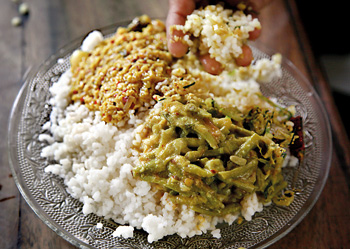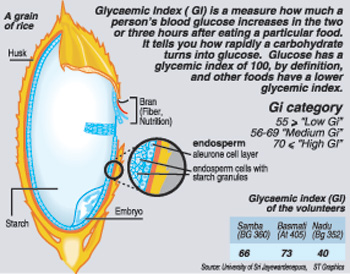As polished or unpolished, white or red, vied for a place on the plate of Sri Lankans well known as rice-eaters and the rice-diabetes link came under the microscope internationally, local experts urged that parboiled is the best.
Parboiled (thambapu) rice has a Glycaemic Index (GI) even lower than some varieties of the much-touted basmathi, points out Prof. Sagarika Ekanayake, a biochemist attached to the Sri Jayewardenepura University whose team has carried out invaluable research on food (see graphic).
Her assurances followed a study published in the British Medical Journal on March 16 that a daily serving (nearly 160 grams) of polished or white rice, increased the risk of Type II diabetes by 11%.
Based on the study of 352,384 in China, Japan, the United States and Australia, who had been followed up for four to 22 years by a research team from the Harvard School of Public Health, Boston, a "positive association" between a diet of white rice and increased risk of diabetes had been found in the Asian countries where people eat rice as their staple food.
 |
| Eat a balanced meal and not a mountain of rice. Pic by M.A. Pushpa Kumara |
Dealing with the nitty-gritty of how the paddy yield comes from the muddy fields of the countryside to be sold in the market, Prof. Ekanayake explains the composition of the rice-grain, be it red or white.
"The grain is in a husk and the outer-most layer of the grain is bran followed by a layer of protein, with the inner-most core being starch," she says. Once the grain is de-husked (to remove the husk) and polished (removal of bran), the bran consisting of vital vitamins, mainly B, protein (loss is more if the germ is also removed) and fibre is lost.
Whether the rice is "healthy or not" would come about from what the grain is subjected to, the Sunday Times understands.
Looking closely at milling (de-husking and polishing), Prof. Ekanayake says that this removes not only the husk but also the bran in the raw rice. The amount of bran which gets destroyed by polishing would depend on the intensity - the extent or degree of polishing will determine how much of the bran and germ will get destroyed, leaving only the starchy core. If the rice is polished and on top of that washed many times, many essential nutrients would be lost.
Linking the bran to the Glycaemic Index (GI), Prof. Ekanayake points out that bran helps to decrease the glycaemic response, as fibre in bran prolongs digestion and absorption of glucose (starch when digested is converted to glucose) thus preventing the blood glucose levels from shooting up. The nutrients in bran include dietary fibre, water soluble vitamins, some essential minerals and some chemical compounds which act as antioxidants and blood sugar lowering agents (eg: anthocyanins in red rice bran).
Therefore, when white and red are put on a scale, the healthier choice would be red, the Sunday Times learns.
Going back to basics and the traditional way that our ancestors prepared healthy rice, Prof. Ekanayake turns the focus on parboiled rice. When the rice is immersed in water and boiled or steamed, the starch within the grain absorbs the water and gets gelatinized. In this process the nutrients of the outer-layers of the grain move in and get enmeshed in the starch. Therefore, when parboiled rice is de-husked and polished the loss of nutrients will be less.
 |
Parboiled rice has a translucent or glassy (shiny) effect when scooped up into the palm, she says, adding that dietary fibre is high in this rice.
Therefore, the glycaemic response is very low, she stresses, and she is talking with evidence in hand. For, one of her M.Sc students, Nisanka Somaratne who researched the Glycaemic Indices of some varieties of rice had found that parboiled rice (nadu) had the lowest GI, with samba (kiri) coming next and basmathi (samurdhi variety) last.
When cooking rice, what should be kept in mind is not to overcook it as the starch gets gelatinized to a high extent and may contribute to a high glycaemic response.
Another positive for the Sri Lankan rice plate is that rice is generally not eaten alone but with a kola mallung (green leafy salad), pulses such as dhal and vegetables. Since these contribute to dietary fibre and induce satiety, the intake of rice will be reduced.
A study by another student had found that when a person ate plain red rice and kiri hodi, the GI is very high as opposed to a meal of rice and curry including green leaves, vegetables and dhal. It has also been shown that it would be better to eat mung-kiribath (milk rice and green gram) than kiribath alone as the GI of mung kiribath is less.
"If you are eating a little rice even in the morning mix it with a little sambol, vegetable or legume if difficult to make many curries," she advises.
However, Prof. Ekanayake urges that just because the GI is low in parboiled rice doesn't mean that we should eat a mountain of rice. People should pay more attention to the rice portion they eat, while a balanced meal is essential which not only includes vegetables but also fruit.
Each person should also take into account the energy requirements and activity level when dishing out a meal, she says, explaining that a sedentary person should not eat excess carbohydrates (starch and sugar) as they get accumulated in the body as fat.
The Sri Lankan rice meal is good if it is well-balanced, is Prof. Ekanayake's verdict.
Beware of sweet treats during festive season
Beware of the festive seasons, urges the Head of the Department of Nutrition of the Medical Research Institute, Dr. Renuka Jayatissa.
During the time of the Sinhala and Tamil New Year, Christmas, Ramazan or Thai Pongal, people tend to splurge, sending their carb-intake sky-high, she points out, adding that no one is advising against having a kevum, mung kevum, kiribath and a piece of cake for a meal, but when you do, be cautious of what you eat for the next meal.
“If you indulge in a lot of high-sugar stuff once a day, eat only a little bit of rice for the next meal as sweetmeats like kevum also have carbohydrates,” adds Dr. Jayatissa.
Contrasting the different varieties of rice in the light of the international research, this Consultant Nutritionist says that one may be tempted to eat a lot of samba during a meal because the grains are smaller than other varieties, absorption to the digestive system quicker, satiation not too good because you feel hungry quicker.
In red rice even if polished slightly, the grains are bigger, absorption to the digestive system takes longer and satiation or feeling full comes quickly with a little rice as it is full of fibre, she points out.
She too echoes the view that another factor which comes into play in a diet is that GI cannot be taken alone but as part of the glycaemic load of all the food eaten during that meal.Reiterating the importance of eating a balanced diet inclusive of carbohydrate, protein, a little fat and vitamins and minerals, she advises that for a sedentary person or office worker, the cooked rice portion should be two to two and a half tea cups as opposed to three or four cups for a farmer toiling in the fields or a labourer carrying heavy loads.
But, the person should also be conscious of any other carbohydrates that will be on the same plate. If there is kos (jak), breadfruit, manioc, bathala or even potato with the rice, then the rice quantity should be reduced, it is learnt.
Focusing on the people who are on the critical brink of diabetes, Dr. Jayatissa says one in 10 Sri Lankans is in this danger zone. They include those who are over 40; overweight have been a low-birth weight baby; have a family member who has diabetes; have had diabetes during pregnancy (gestational diabetes); and have metabolic syndrome. Metabolic syndrome is having central obesity (fat around the waist), she adds, explaining that an alarm should ring if a male’s waist circumference is more than 36 inches and a female’s more than 32 inches.
Don’t tip the scales by putting unhealthy food into your mouth, but prevent sliding into illness and diabetes, adds Dr. Jayatissa. |



